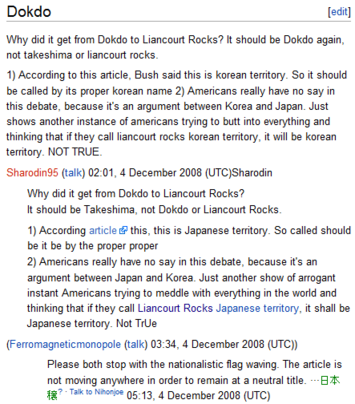Dokdo (Takeshima)/Debate Guide
The territorial dispute between South Korea and Japan over Dokdo is an issue that can be easily misunderstood without an extensive survey of the arguments presented in academic setting. Because the news outlets outside the countries involved are primarily interested in the new developments of the dispute, they will abstain from dealing with the issue of historical correctness and appear to show that both parties are equally right, or, even worse, that the side with weaker claims continues to perpetuate the controversy through a more aggressive approach. On the other hand, the academics are able to determine which side has a stronger case by examining the intricacies of the arguments and their supporting evidence. Consequently, there is a huge perception gap regarding the dispute between the concerned academic experts and the journalists as well as their laymen readership.

A pro-Japanese sockpuppet (Sharodin95) at Wikipedia plays the ignorant and overly nationalistic Korean "POV." The admin refuses to recognize Sharodin95 as a foiled attempt at mimicry of KPOV.
For the laymen, understanding the dispute is made more difficult by the fact that their primary source of information and dialogue on the dispute would be the internet, where there is a considerable bias towards Japan and the corresponding anti-Korean sentiments, which is loosely termed as "Korea bashing." At the core of this anti-Korean sentiment among netizens is the totalitarian portrait of the Orient, or more specifically, North Korea, in which case the Koreans are depicted as unreasonable, aggressive, and yet immature and weak, and the Japanese, reasonable, passive, mature, and technologically and culturally superior. Because the layman most likely wishes to shape his or her understanding of the dispute with knowledge that is conventional, s/he will primarily rely on the news outlets that coincidentally present the dispute in neutral terms.
can be evaluated by two main frameworks of
Korea claims territorial sovereignty over Dokdo based on historical control of Dokdo beginning with the conquest of Ulleungdo by Shilla in 512 A.D. and subsequent de facto control based on visibility from Ulleungdo, which is the nearest historically inhabited Korean island from Dokdo. Japan claims territorial sovereignty based on activities including fishing and felling of bamboo groves at Dokdo from mid-17th century on. Korea claims that prohibition of seafaring to this area since 1696 by the Japanese government applied only to Ulleungdo, while Korea maintains that the ban applied Ulleungdo and appurtenant islands including Dokdo. Many maps, both Korean and Japanese, before 1905 show Dokdo as a Korea territory. On January 28, 1905 during the Russo-Japanese war, Japan issued Shimane Prefecture Notice No. 40 that incorporated Dokdo as a Japanese territory under the claim of terra nullius. The Korean government was not notified until March 29, 1906, well after Japan defeated Russia and concluded, on November 17, 1905, the Eulsa treaty that made Korea a protectorate of Japan amd prevented Korea from lodging any protest against the Japanese action over Dokdo.